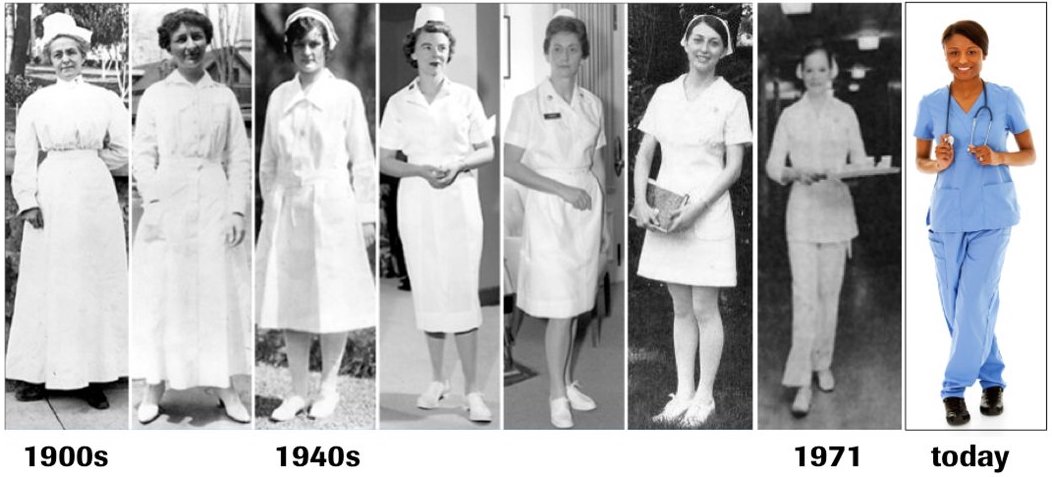Every person who has ever suffered a medical injury has been treated by a person in a white coat. Have you ever wondered why doctors wear white coats and where this tradition originated? Has the symbol of health care always been only white? The medical garment, like all things, did not just come about. So let's take a look at the evolution of how such clothing came about and what colours are typical of healthcare.

The history of physicians' clothing is long and fascinating, with the earliest known examples dating back to ancient civilisations. In ancient Egypt, for example, doctors wore white linen robes as a symbol of purity, while in ancient Greece doctors wore long flowing robes known as himations, which were made of wool and often decorated with intricate patterns.
During the Middle Ages, the dress of doctors continued to evolve, with many doctors adopting the robes and cloaks worn by scholars and professors of the time. These garments were often made of heavy, luxurious fabrics, such as velvet or silk, and decorated with embroidery or other decorative elements. During a plague epidemic that killed millions, doctors protected themselves with beaked masks, leather gloves and long coats. Otherwise, up until the 19th century, it was typical for doctors to wear civilian clothes, often black, and the doctor-patient encounter was considered formal.

With the further development of medicine and health care, the nurses' clothing was also renewed. The first changes in clothing came during the Crimean War. The nurses' clothing consisted of long white dresses, white aprons and, above all, the cap, which was essential for this time and was considered their symbol.
1940s
It was not until the Second World War that major changes in dress took place. At this time the increase in patients was very high. In order to move quickly and treat as many patients as possible, medics needed more comfortable and practical clothing. Therefore, for the first time, short sleeves and shortening of the dress to the knee are found in the uniform.

1960s
Medical dress changed with the introduction of uniforms for nursing brothers. They wore simple white jackets with a high collar to ensure a clean appearance and partly to prevent the spread of infection. This type of clothing brought something completely new to the field.
1980s
At this time, the medical uniform became much less formal and polyester began to be used instead of cotton material.
1990s
As time went on, blouses came into vogue and are still popular today with white coats. Blouses, or "scrubs", are simple, comfortable and cheaper products that are easy to design and alter.

What about the colors?
As the level of health care gradually increased, more attention had to be paid to hygiene and sanitation. Therefore, work clothes for health workers were introduced, on which dirt and blood had to be clearly visible. The garments were therefore made white and this tradition has been preserved to this day. As time went on, it was found that too much of anything was bad for you, and so other colours were introduced into the medical profession. This was especially true for surgeons, who noticed that the colour white was very tiring to the eyes and that an unfocused surgeon could be very dangerous. Light green and turquoise are ideal colours to address this problem. Even on these colors, any dirt and blood are easily visible. Plus, after a few washes, they don't look as worn as the white ones, and the color environment is definitely more pleasant for the patient's psyche.
And how do we see the dressing of medical staff?
When our company started in the market 6 years ago, medical garments were very cheap, low quality and bought in bulk by hospitals at the lowest possible price. That's why we decided to create our own clothing that is comfortable, high quality, but most importantly nice and makes the paramedic feel good. As time went on, the paramedics started to realise this and became interested in the clothing that the hospital provided them with. Many of you buy clothes at your own expense, mainly because you want to feel good, comfortable and confident in your work. White polo shirts and blouses have become the most popular workwear, especially coloured blouses along with matching trousers. We feel that the environment in hospitals is changing and that, for example, in the outpatient clinic you will see healthcare workers in colour much more often. We are very happy that you want to join us in making a change for a better healthcare system where both the staff and the patient can feel comfortable.

Recently, there has been a trend towards civilian clothing, which should be more comfortable and friendly for patients. Doctors often argue that patients feel better in such an environment and it has a better impact on their psyche. However, it must not be forgotten that the wearing of civilian clothes has been changed since the Middle Ages. Even at that time, health professionals were aware that wearing work clothes prevented the possible transmission of germs, whether from hospital to home or vice versa. Therefore, we think that every doctor should wear workwear that meets hygiene measures and thus protect not only themselves, but above all their surroundings.
The white coat has been the main symbol of the health sector for more than 100 years. Even though medical garments are constantly being modified and improved, the white coat remains a symbol of medical authority and respect. You can buy this and other medical garments in the highest quality and in all possible colours on our website in the clothing category.
Author of the article: Marek P.









